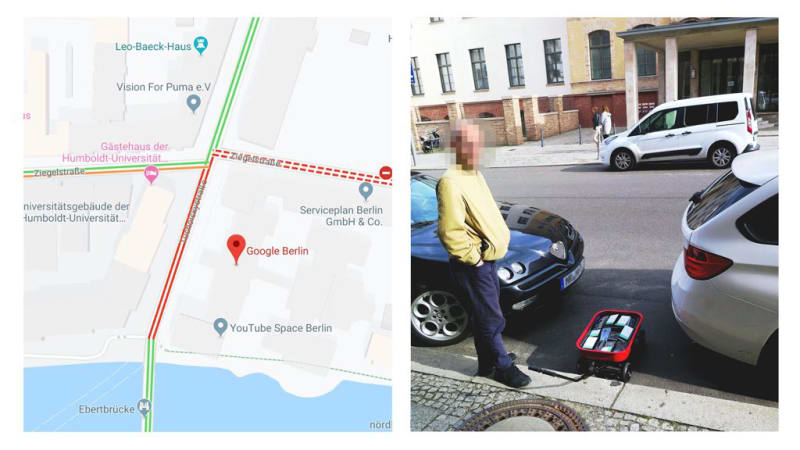Performance artist creates virtual traffic jams with 99 smartphones
https://ift.tt/2tqF7XF

Simon Weckert, at times, carries 99 smartphones with him, and none are for personal phone calls. Or texts, or emails, tweets, or photography. All 99 devices spend their battery capacities on Google Maps and Google Maps only. Weckert is a Berlin-based artist who experiments with how the digital and real worlds correlate, and his newest work plays with the idea of traffic jams in 2020. By putting 99 smartphones into a small hand-pulled wagon, Weckert becomes a walking digital red line.
Weckert just released his new performance and installation called “Google Maps Hacks.” On his website, the main text that accompanies his video and images is an excerpt from somebody else’s work, “The Power of Virtual Maps” by Moritz Alhert. Part of the copy reads:
“The advent of Google’s Geo Tools began in 2005 with Maps and Earth, followed by Street View in 2007. They have since become enormously more technologically advanced. Google’s virtual maps have little in common with classical analogue maps. The most significant difference is that Google’s maps are interactive – scrollable, searchable and zoomable. Google’s map service has fundamentally changed our understanding of what a map is, how we interact with maps, their technological limitations, and how they look aesthetically. In this fashion, Google Maps makes virtual changes to the real city. …
“With its Geo Tools, Google has created a platform that allows users and businesses to interact with maps in a novel way. This means that questions relating to power in the discourse of cartography have to be reformulated. But what is the relationship between the art of enabling and techniques of supervision, control and regulation in Google’s maps? Do these maps function as dispositive nets that determine the behaviour, opinions and images of living beings, exercising power and controlling knowledge? Maps, which themselves are the product of a combination of states of knowledge and states of power, have an inscribed power dispositive. Google’s simulation-based map and world models determine the actuality and perception of physical spaces and the development of action models.”
With this understanding of how the virtual world and the real world are intertwined, Weckert asks more questions of how these realities can be changed and manipulated. Describing “Google Maps Hacks,” Weckert wrote, “99 second-hand smartphones are transported in a handcart to generate virtual traffic jam in Google Maps.Through this activity, it is possible to turn a green street red, which has an impact in the physical world by navigating cars on another route to avoid being stuck in traffic.”
Thus, something he does in the real world directly affects the virtual world, which in turn creates a ripple effect in the real world, depending on how others are using the perceived reality and information.
Weckert, who was born in Germany and studied New Media Art at Berlin University of Art, has several other maps-related works, as well. Read more about Weckert, see his other works, and think on “Google Maps Hacks” on Weckert’s portfolio.
99 smartphones are transported in a handcart to generate virtual traffic jam in Google Maps. Through this activity, it is possible to turn a green street red which has an impact in the physical world by navigating cars on another route! #googlemapshacks https://t.co/3gixMxopE6 pic.twitter.com/6KcMm1XgAF
— Simon Weckert (@simon_deliver) February 1, 2020
Auto Blog
via Autoblog https://ift.tt/1afPJWx
February 3, 2020 at 10:46AM
